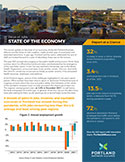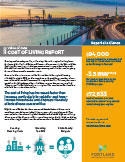Growing and attracting quality, well-paying jobs to the region has long been the focus of the Portland Business Alliance and its partners in the Value of Jobs Coalition. But creating an inclusive economy requires more than job growth. Affordability is another key to a thriving economy, and it has been an ongoing theme of these annual economic reports.
A report in this series was one of the first to identify the region’s housing affordability crisis in 2016, and last year’s report showed how a number of new taxes affected disposable incomes of the region’s families. This year, the report considers the full package of household expenses and compares so-called “living wages” in Portland and its peer regions. The conclusion: Portland is a relatively expensive place to live.
The cost of living has increased faster than incomes, particularly for middle- and lower-income households, and disproportionately affects diverse communities
Report at a Glance
Portland’s Living Wage
High shares of Portlanders have expressed dissatisfaction with economic conditions even during periods of rising wages and strong job growth. That was true before the onset of a global pandemic. A relatively high cost of living drives some of the discontent. Past Portland Business Alliance reports have pointed to the high, and rising, costs of housing, but that is not the only area where Portland’s costs stand out.
A living wage calculator, published by the Massachusetts Institute of Technology (MIT), highlights the household budget challenges that families in the region face. The calculator reports the annual income a family must earn to support itself without common government supports and subsidies. MIT’s calculator evaluates income needs of 12 different family configurations that vary in their numbers of children and adults, as well as the work status of the adults.
The analysis finds that a household in the Portland metro with two adults and no children must earn nearly $55,000 annually, before taxes, to achieve self-sufficiency. Portland households with one adult and two children need nearly $86,000 to be self-sufficient, and those with two adults and two children need nearly $94,000. See Figure 14.
The calculator also allows comparisons across regions. The nearly $94,000 needed by Portland’s household with two adults and two children is slightly less than Seattle’s figure, but about $7,000 more annually than is required in Austin and over $15,000 more than is needed in Nashville. See Figure 15.
Portland’s high costs of housing, childcare, and taxes explain most of the difference between the living wage here and elsewhere. To reach self-sufficiency, the four-person Portland family needs to spend $17,940 on housing (i.e., rent, utilities, and property taxes) while peers in Indianapolis and Nashville spend only $11,202 and $13,495, respectively.
Portland’s living wage—the wage required to achieve self-sufficiency without the need for most public subsidies—is similar to Seattle’s and higher than other peer cities
Tax Burden & Child Care
Beyond housing, taxes play a big role in the interregional differences. Portlanders not only have to earn more to become self-sufficient but also face higher tax rates along the way. Based on a study of tax rates in the largest city in each state, a Portland family with a $75,000 income pays 10.2 percent of that amount in income, property, sales, and automobile tax—a tax burden 3.5 percentage points higher than Seattle’s for a family with the same income and nearly 5 percentage points higher than Nashville’s. See Figure 16.
Smaller intercity cost differences exist for childcare and food. In the case of childcare, Portland’s higher costs, while challenging for families, are supporting better working conditions in a historically low-wage industry.
The cost of living has increased faster than incomes, particularly at the median and below on the income distribution, and disproportionately impacts diverse communities
Portland-metro households with two adults and two children and a Hispanic or Black head of household are one third to one half as likely to earn a living wage as those with a White head of household. See Figure 17.
Adjusted for the cost of living, Portland’s median household income is the second lowest among the peer regions. See Figure 18.
Why this matters
These and the MIT findings suggest that remedies to the region’s cost-of-living challenges will need to come from both the income and expense side of household budgets.
As always, elected officials and economic developers should aim to attract and grow better-paying jobs. Simultaneously, they should advance policies that curb the high price of housing and ease the tax burden for lower- to middle-income families.
Related Report
DATA ANALYSIS/SOURCES:
In this report, the Portland region refers to the Metropolitan Statistical Area (MSA) of Portland-Vancouver-Hillsboro, OR-WA, except where otherwise noted. Metrics also compare the Portland region to other metropolitan “peer” regions. These comparator regions were selected and based on a number of indices found in the U.S. Census Data. Data and analysis provided by ECONorthwest.
This report is presented to you by:
Value of Jobs Coalition Partners
With gratitude to ECONorthwest, our State of the Economy partner for 12 years and counting!







